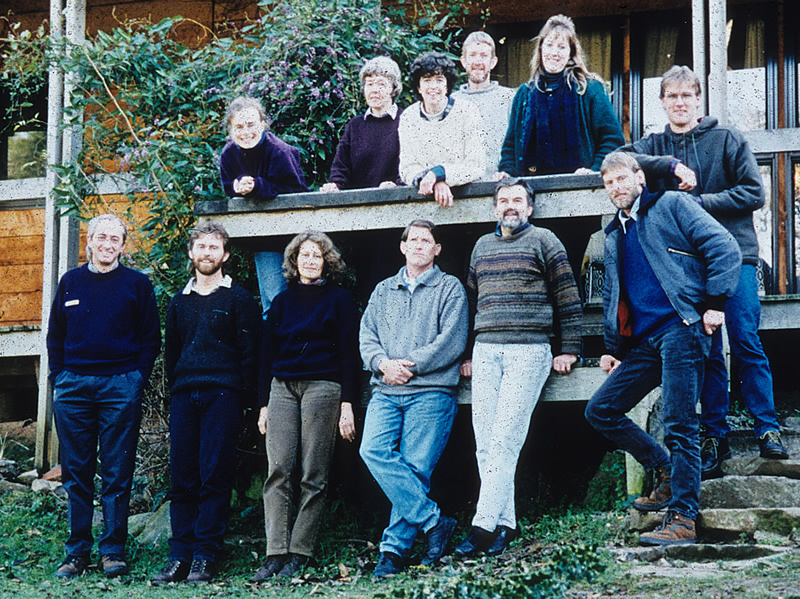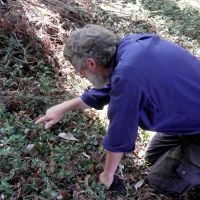Farewell to Lindsay Smith and Chris Winks
It is with great sadness that we bid farewell to two of our talented and dedicated weed biocontrol technicians, Lindsay Smith and Chris Winks, who are retiring at the end of February and March, respectively. They have both had long careers at Manaaki Whenua – Landcare Research (MWLR) and its predecessors, making a significant contribution to the conservation of New Zealand’s biodiversity and the management of invasive alien plants. We thank Chris and Lindsay for their outstanding contributions and wish them a happy and fulfilling retirement. Fortunately, both are planning to sign up to be MWLR research associates (an unpaid honorary role), and we are glad that we will still be able to call upon their expertise from time to time. Below are some of their career highlights.

Chris Winks
Chris Winks started at the Department of Scientific and Industrial Research (DSIR), the predecessor of MWLR, in the mid-1980s. Chris was first tasked with wading through swamps and lakes infested with alligator weed (Alternanthera philoxeroides) in Northland and Auckland to release and monitor the alligator weed beetle (Agasicles hygrophila). After about a year and a half he emerged from the swamps and moved on to “yellower pastures”, assisting with the release and monitoring of the ragwort (Jacobaea vulgaris) flea beetle (Longitarsus jacobaeae).
After a few years of working solely in weed biocontrol, Chris teamed up with the DSIR Insect Rearing Team and divided his time between rearing pest insects for agricultural research and beneficial insects for weed biocontrol. In addition to Chris’s contributions to this research, some of the work he found the most rewarding and enjoyable was his contribution to the protection of some of New Zealand’s most iconic endemic species. Perhaps his greatest claim to fame was his part in saving the Mercury Island tusked wētā (Motuweta isolata) from the brink of extinction. When this carnivorous species of wētā was discovered in 1970 it only occurred on Middle Island, an area of just 13 hectares, making it highly vulnerable to extinction. Once the precarious existence of the species was known, the Mercury Islands Tusked Weta Recovery Group, formed in 1990, aimed to establish new populations of the wētā on other islands in the Mercury island group. However, the wētā’s rarity and confinement to one small island made wild-to-wild transfers of populations very risky, which called for a captive breeding programme. The rearing methods were developed by Chris and a co-worker, Graeme Ramsay, and a captive population was initiated with just two female and one male wētā. Offspring from the captive breeding programme were released on two nearby islands in 2000 and 2001, significantly reducing the chances of accidental extinction, and maximising the potential for the long-term survival of this large, secretive insect.
As well as rearing endangered wētā, Chris has reared many weed biocontrol agents that have been shipped and released all over New Zealand. His ability to successfully rear all kinds of insects results from his extensive experience, but also considerable dedication and commitment to the task. Chris has also helped with numerous site visits to subsequently check for establishment of the progeny.
Other important work that Chris has been involved with include his collaboration with Ross Beever (a former plant pathologist with MWLR) to identify the insect vector responsible for transmitting a disease of New Zealand’s native cabbage trees known as cabbage tree sudden decline. Chris also worked with Ross and Stan Bellgard (another plant pathologist, previously with MWLR) on kauri dieback, and with Robyn Simcock (MWLR) on green roof projects, which aim to reduce the negative environmental effects of urbanisation.
One of Chris’s favourite aspects of his weed biocontrol research was his surveys of invertebrates already associated with many weed species in New Zealand. This work has meant that Chris has become extremely knowledgeable about our invertebrate fauna. His accumulation of a large numbers of insect specimens over the years promises to keep him busy during his retirement, as Chris plans to develop a properly curated insect collection. But, according to Chris, there will also be time for “other fun things”.

Chris observing tradescantia leaf beetle damage

Chris and Rob Chappell (DOC) releasing Mercury Island tusked wētā

Chris discovers that bridal creeper rust is in New Zealand
Linday Smith
Lindsay Smith’s tenure with MWLR started in 1993, when it was a newly minted Crown Research Institute (CRI). What was originally only a 3-week contract turned into 26 years at Lincoln! Prior to that Lindsay also worked for the DSIR at Lincoln as an intern in the summer of 1979, sampling invertebrates in a pesticide trial. In between, Lindsay tried his hand at a number of things including bee-keeping, bird monitoring and banking, before he was lured back.
Lindsay’s first assignment was to help Pol Syrett to curate a collection of insects from broom (Cytisus scoparius) in Spain. It wasn’t long before Lindsay became involved in other biocontrol projects, which meant many hours spent in containment, testing and tending newly imported candidate biocontrol agents. According to Lindsay, he spent many, many, many hours and days shut away working in small containment cells. This kind of work takes a special kind of dedication, with insect cultures sometimes needing attention on weekends and public holidays.
Over the years Lindsay has been involved in a number of weed biocontrol projects, from alligator weed (Alternanthera philozeroides) to hieracium (Pilosella spp.), to tradescantia (Tradescantia fluminensis). One of Lindsay’s most memorable projects was one of his first, which involved the introduction of heather beetles (Lochmaea suturalis) from the UK to control heather (Calluna vulgaris) on the Central Plateau. At the outset the project seemed straightforward. A voracious beetle had been identified as a biocontrol agent, host specificity testing could be done with relative ease, the beetle would be released, and the heather would be a problem solved. However, it soon became something of a fraught journey: there was a battle to overcome a fungal parasite in the imported beetles, ministerial sign-off was required to release the exotic beetles in Tongariro National Park, and in 1996, the Mt Ruapehu eruption coated many of release sites with a thick layer of volcanic ash! Trying to put a positive spin on ash-covered heather was difficult. Nonetheless, some beetles survived, and with a little nurturing over the years by Paul Peterson they have persisted and now look to be well on their way to decimating the Tongariro heather stands. Also involved in the heather project was a collaborator in the UK, Simon Fowler, who later moved to MWLR and became Lindsay’s manager for many years.
When funding for biocontrol of weeds became a bit scarce, the need to be flexible in sourcing other work allowed Lindsay to rekindle his interest in birds, having once worked for the Wildlife Service, a predecessor of the Department of Conservation (DOC). Phil Lyver generously offered an opportunity spanning several seasons to work in his team surveying grey-faced petrel populations on islands off the Coromandel, and later the Adelie penguin in Antarctica. Lindsay attributes his time in the field with Phil to his descent into a long-lasting gummy jet plane addiction!
Sourcing, testing, rearing and releasing insect biocontrol agents takes time, with many years of sustained energy and commitment required to see a project succeed. Some biocontrol programmes take decades to see significant, discernible impacts, so a quarter of century on Lindsay is well pleased with some tangible results from his contribution to weed biocontrol.
Looking back on his career, Lindsay says he feels grateful to have had so many opportunities to work with outstanding people – enthusiastic, passionate, generous and knowledgeable people. They include his immediate colleagues, the wider organisation, the many overseas collaborators essential to our work, and the end users in New Zealand – the farmers, regional council staff and general public. “All have shared my journey at MWLR to make it a most enjoyable 26 years, thank you,” said Lindsay.

Lindsay meeting the Antarctica locals

Lindsay releasing hieracium gall wasps.

Lindsay rearing tradescantia beetles in containment.
